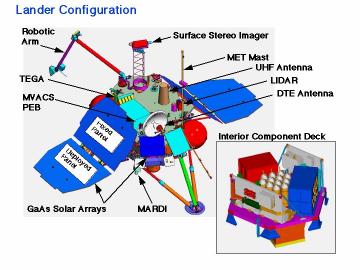

Mars Polar Lander
Spacecraft Description
Mars Polar Lander Spacecraft Detailed Flight System Description
Spacecraft Configurations
Science Payload
Deep Space 2
MVACS
MARDI
LIDAR
Microphone

The lander spacecraft is 3-axis stabilized during the cruise phase and during the entry, descent, and landing event except while descending under the parachute. Lander unique hardware required to accomplish the landing include an aeroshell and parachute with Viking and Mars Pathfinder heritage; and a modified, military 4 beam doppler radar to update trajectory estimates during the terminal descent phase. RCS thrusters are used to maintain spacecraft attitude during flight. The lander employs the same star camera, inertial measurement unit, transponder, solid state power amplifier, RAD6000 processor, and power subsystem electronics as the orbiter. Primary communication between the lander spacecraft and earth during cruise are via an X-band link through a fixed medium gain antenna mounted on the cruise stage. The primary downlink communications during the surface mission are via a relay link through either the Mars Global Surveyor orbiter or the 1998 Mars Surveyor orbiter. The relay links are backed up by a direct link to Earth via an articulated (2 axis) medium gain antenna mounted on the lander deck. Commands are transmitted direct from Earth to the lander via the medium gain antenna. Power is generated using two gallium arsenide solar array wings (total area 3.1 m2) mounted to the cruise stage during cruise and via two gallium arsenide solar array wings (total area 2.9 m2) deployed from the lander after touchdown on the Martian surface. NiH2 16 amp-hour common pressure vessel batteries provide power during low solar insolation periods and during peak power operations. A loop heat pipe is the primary method of lander thermal control and all temperature sensitive electronics are isolated within an insulated thermal enclosure. The lander structure, like the orbiter, is aluminum honeycomb with composite face sheets. The mass of the lander spacecraft at launch is estimated at 618 kg fully fueled with a dry mass of 562 kg including the micropenetrators.
| Home | Mars Polar Lander | Deep Space 2 Microprobes | Mars Climate Orbiter |
| Welcome | Mailing List | Links | Credits |
For questions or comments on this website please refer to our list of contacts.